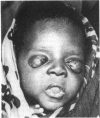Abstract
We report on 2 infants, one with a bilateral and the other with a unilateral corneal metaplasia. The first case with bilateral corneal metaplasia showed shortening of both upper and lower lids with formation of symblephara. By ultrasonography the right eye presented with microphthalmos, aphakia, and persistent hyaloid, whereas the inner parts of the left eye appeared to be normal. The question remains to be answered whether this is an abortive cryptophthalmos leading to bilateral corneal metaplasia or a primary corneal metaplasia inhibiting the lid growth. No suggestions concerning the aetiology are made. The second case presented with a unilateral corneal metaplasia, normal eye lids, aphakia, and microphthalmos. This aberration was probably caused by an amniotic band, as it is associated with malformation of the nose on the same side. In case 2 the dermoid was excised and a lamellar corneal graft performed. The histology is reported.
Full text
PDF



Images in this article
Selected References
These references are in PubMed. This may not be the complete list of references from this article.
- Henkind P., Marinoff G., Manas A., Friedman A. Bilateral corneal dermoids. Am J Ophthalmol. 1973 Dec;76(6):972–977. doi: 10.1016/0002-9394(73)90091-3. [DOI] [PubMed] [Google Scholar]
- Mann I. A RARE CONGENITAL ABNORMALITY OF THE EYE. Br J Ophthalmol. 1930 Jul;14(7):321–330. doi: 10.1136/bjo.14.7.321. [DOI] [PMC free article] [PubMed] [Google Scholar]
- SINHA P. N., MISHRA S. Corneal dermoid; report of a case. Am J Ophthalmol. 1950 Jul;33(7):1137–1141. [PubMed] [Google Scholar]
- Zaidman G. W., Johnson B., Brown S. I. Corneal transplantation in an infant with corneal dermoid. Am J Ophthalmol. 1982 Jan;93(1):78–83. doi: 10.1016/0002-9394(82)90702-4. [DOI] [PubMed] [Google Scholar]







